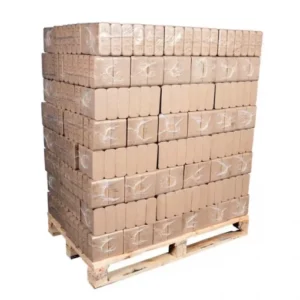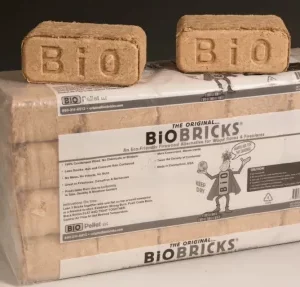Buy Pini Kay Briquettes Online
Pini Kay Briquettes
Solidbiofuels.com Pini Kay Briquettes burns slowly which gives off more heat, thus saves money. The unique technology of producing this briquette enables aesthetic combustion, without absorbing moisture from the air, and prevents contamination of heating devices. The hole in these briquettes reduces the amount of smoke.
Pini Kay Briquettes are made from pine or hardwood (oak) sawdust, pure wood, 100% natural and eco, without any chemical additives or binders, with natural smell and color of the wood. Our Pini Kay Briquettes (heat logs) are suitable for home heating and for commercial purposes.
These briquettes are produced by pressing dry chipped wood at high pressures and high temperatures. They have the maximum burning time and produce the maximum useful heat. Pini Kay Briquettes are remarkably resistant to mechanical action and moisture and store well.
Wood briquette is one of the most nature friendly biofuel, produced of the leftovers of timber industry. Briquettes consist of sawdust pressed into bricks. No additives are added during the production process as sawdust is glued together by natural adhesive lignin that is present in wood. Wooden briquette has a very low moisture content, high density and energy value.
A briquette is a French word and also spelled as briquet, is a compressed block of coal dust or other combustible biomass material e.g. charcoal, sawdust, wood chips, peat, or paper used for fuel and kindling to start a fire. The term derives from the French word brique, meaning brick.
Heat log dimensions: 315-320*50*50mm
Heat log central hole diameter: 20mm
Heat logs 10kg pack dimensions: 320*210*160mm
Ash content: <0.7%
Moisture: <8%
Calorific value: 5.1 kWh/kg (4400 kcal/kg or 18.5 MJ/kg)
Specific density: 1.2 g/cm³
The sulfur content: ≤0.05%
100% natural ecologically clean raw material: pine or hardwoods, pure wood
Quality guaranteed
Application & Uses of Pini Kay Briquettes:
Boilers (sugar mills, paper mills, chemical plants, Cement, food processing units, oil extraction units etc.) using fuel for steam generation and heating. Pini Kay Briquettes
Unlike the pure lump charcoal, briquettes are manufactured from wood by-products compressed with additives that help them light and burn consistently. They provide a more stable burn, maintaining a steady temperature for a longer period of time with less hand holding then lump charcoal.
Biomass briquettes are a biofuel substitute to coal and charcoal. Briquettes are mostly used in the developing world, where cooking fuels are not as easily available. There has been a move to the use of briquettes in the developed world, where they are used to heat industrial boilers in order to produce electricity from steam. The briquettes are cofired with coal in order to create the heat supplied to the boiler.
Fuel briquettes generated by the low-pressure compaction of paper, sawdust, agricultural or yard waste, etc. currently serve as an alternative to firewood, wood pellets and charcoal in developing countries in Africa, Asia and South America. Pini Kay Briquettes
The materials for bio briquettes including paper, leaves, pine needles, sawdust and shop waste were ground into particles of 6 to 8 millimeters (mm) in diameter to increase surface area for soaking and to enhance packing efficiency. Briquettes made entirely of shredded paper were prepared by the addition of just enough water to cover the material and soaked for approximately one week. As the ratio of biomass to shredded paper increased, the amount of time required to soak the material for successful molding also increased. For instance, bio briquettes made entirely of shredded leaves required approximately five weeks soak time before pressing. The soaked material was tested for readiness by pressing a scoop of the mash by hand. Mash that held its form in the palm of the hand was considered ready to be pressed into briquettes. Pini Kay Briquettes
Pini Kay Briquettes Combustion Analysis:
The combustion tests were carried out in a fume hood with a face velocity of 30.5 meters (m) per second, to provide a steady flow of air. Biobriquettes, weighing on the order of 100 g each, were placed on a wire mesh stand 21 centimeters from the floor of the hood and enclosed in a modified Weber chimney stove topped with wire mesh.
A Bunsen burner placed under the briquette served as the ignition source. Once the biobriquette had begun to combust, the ignition source was removed and a 2-liter (L) aluminum saucepan containing 500 milliliters (mL) of deionized water was placed on top of the stove (Figure 2). This process was implemented in order to monitor the heat output from the biobriquette once the Bunsen burner was removed.
The temperature of the water bath was recorded by the Vernier Logger Pro device interfaced to a computer, which measured the temperature change in the water every second over a span of 4,000 seconds (just over an hour). The four types of briquettes mentioned earlier were combusted in this study. In addition, traditional fuels including charcoal, wood and wood pellets were ignited and energy output was monitored under the same set of conditions (i.e. mass of 100 g, consistent ignition time by Bunsen burner, same method of recording heat output).
Briquettes of each composition were tested from two to four times whereas traditional fuel sources were tested thrice each.
The combustion characteristics of fuel briquettes made from Idigbo (Terminalia ivorensis) charcoal particles, pinewood (Pinus caribaea) sawdust and their agglomerates using gelatinized cassava peels were investigated. Pini Kay Briquettes
The charcoal particles and pine sawdust were blended in the mixing ratios of 90:10, 80:20, 70:30, 60:40, and 50:50, respectively and vice-versa. More so, briquettes were produced from pure charcoal particles and pine sawdust separately for the purpose of comparison with the blended briquettes.
The gelatinized binder was 5% of the total briquettes weight. The briquettes were produced using a pressure of 5 MPa with a dwelling time of 5 min in a hydraulic briquetting machine. Proximate, elemental compositions and heating value analyses were carried out on the raw charcoal, sawdust, cassava peel, and their briquettes. The results showed that variations in the mixing ratios of the bio-residues had significant effects on all the properties investigated.
An increase in the charcoal particles led to an increase in the fixed carbon content and heating value of the briquettes. Conversely, higher pine sawdust content in the briquette resulted in higher volatile matter content and lower heating value. The briquette made from pure charcoal particles had the highest heating value (24.9 MJ/kg) and ash content (6.0%). Pini Kay Briquettes
Its carbon, hydrogen, and oxygen contents were in the range of 44.6–50.1%, 5.1–5.6% and 34.4–41.5%, respectively. The proximate analysis, elemental composition analysis, and heating values of the produced fuel briquettes depicted that they have better combustion properties when compared to the raw charcoal, pine dust, and cassava peel.




 No products in the cart.
No products in the cart. 
Reviews
There are no reviews yet.